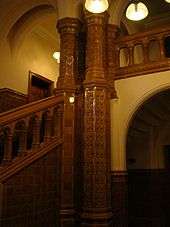Burmantofts Pottery

Burmantofts Pottery was the common trading name of a manufacturer of ceramic pipes and construction materials, named after the Burmantofts district of Leeds, England, United Kingdom.
The business began in 1859 when fire clay was discovered in a coal mine owned by William Wilcox and John Lassey.[1] In 1863 Lassey's share was bought by John Holroyd and the company then named Wilcox & Co.[1]
In 1879, after a period of expansion, the firm made decorative bricks and tiles in orange or buff-coloured architectural terracotta, glazed bricks, and glazed terracotta (faience).[1] Architect Alfred Waterhouse used their materials in his Yorkshire College (1883) in Leeds, and his National Liberal Club (1884) in London.[1]
In 1885 products were on sale in London, Paris and Montreal.[1] By 1889 they had commissioned Maurice Bingham Adams to design stock items for their catalogue.[1] Also in 1889 Wilcox & Co merged with other companies to found The Leeds Fireclay Co. Ltd. — the largest in the country.[1]
Terracotta production ceased in 1904 but the firm created an artificial marble called Marmo in 1908, as used on Atlas House, King Street, Leeds [1] and Michelin House, London.
The firm closed in 1957, at which time it comprised ninety kilns on 16 acres (65,000 m2) of land.[1]
Examples
- Atlas House, King Street, Leeds
- County Arcade, Leeds (Frank Matcham)
- Great Hall interior, University of Leeds, 1890-4, (Alfred Waterhouse)
- Michelin House, South Kensington, London
- National Liberal Club, London
- London Road Fire Station
References
External links
- Burmatofts Pottery Shards
- BBC Leeds Local History Glazing over
- Tessellations
- Understanding Terracotta